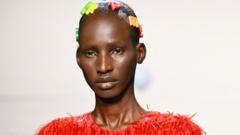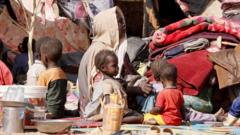South Sudanese models are making significant strides in the global fashion world, with their distinct beauty gaining wide acceptance. Despite challenges like civil war and familial skepticism about modeling, talents like Arop Akol and Anok Yai prove that resilience and style can pave the way for success.
The Rise of South Sudanese Models: Beauty in Adversity

The Rise of South Sudanese Models: Beauty in Adversity
South Sudan is emerging as a powerhouse in the fashion industry, with models gaining international fame amid personal and national challenges.
Article Text:
In recent years, the world of fashion has witnessed a remarkable surge in the presence of South Sudanese models, who are celebrated for their striking looks and rich cultural heritage. Among these emerging stars is Arop Akol, who has been navigating the international fashion scene for the past three years. Clad in a simple yet stylish outfit, with flowing braids and a fresh-faced look, Akol is the epitome of an off-duty model.
Sitting in the offices of First Model Management in the UK, Akol reflects on her journey from watching fashion shows as a child to sharing runways with icons like Naomi Campbell. "Since I was 11, I dreamed of this career," she shares, noting her experiences walking for prestigious labels in cities like London and Paris.
The modeling world has taken notice of the beauty of South Sudanese individuals, with highlights including models like Anok Yai, Adut Akech, and Alek Wek, who paved the way for future talents. Discovered in a London car park, Wek became a trailblazer in high fashion, representing South Sudanese culture to global audiences.
Today, the trend shows no signs of slowing, with industry platforms highlighting the rising presence of South Sudanese models. In a recent assessment by Models.com, a significant proportion of the top rising models have South Sudanese roots, while Vogue showcased numerous young South Sudanese talents poised for success.
Dawson Deng, co-founder of South Sudan Fashion Week, emphasizes the unique qualities South Sudanese models bring to the table. "They possess the ideal attributes — perfect dark skin and impressive height," he notes, while acknowledging the increasing demand for models reflecting diverse backgrounds.
Yet, challenges remain. Akur Goi, another South Sudanese model, believes that the appeal of South Sudanese women in the fashion scene is rooted in their resilience, a reflection of the struggles they have faced both personally and collectively as a nation. With the backdrop of civil unrest in South Sudan, many have sought refuge in neighboring nations, dreaming of a brighter future.
Akol shares her own obstacles along the path to modeling. After a rocky start with an untrustworthy agency, she later secured representation that respected her integrity. Stories of exploitation are not uncommon, with instances where refugees were underpaid or unable to cover exorbitant fees for representation.
However, as these models gain recognition, societal perceptions are slowly shifting. Once viewed with skepticism and misunderstood, modeling as a profession is increasingly recognized as a viable career path for many South Sudanese women. Deng mentions a young model who, after initially resisting her family's wishes, is now the family's primary breadwinner.
As the world embraces diversity in fashion, South Sudan continues to showcase its beauty in the global arena. Models like Akol and Wek inspire hope for many, proving that talent and determination can triumph over adversity. "South Sudanese models are going to go a long way," asserts Akol, confident that their presence will be permanent in the industry.
With ongoing conversations around inclusivity and representation, the story of South Sudanese models is not just about fashion but also about empowerment, resilience, and breaking barriers on an international scale.
In recent years, the world of fashion has witnessed a remarkable surge in the presence of South Sudanese models, who are celebrated for their striking looks and rich cultural heritage. Among these emerging stars is Arop Akol, who has been navigating the international fashion scene for the past three years. Clad in a simple yet stylish outfit, with flowing braids and a fresh-faced look, Akol is the epitome of an off-duty model.
Sitting in the offices of First Model Management in the UK, Akol reflects on her journey from watching fashion shows as a child to sharing runways with icons like Naomi Campbell. "Since I was 11, I dreamed of this career," she shares, noting her experiences walking for prestigious labels in cities like London and Paris.
The modeling world has taken notice of the beauty of South Sudanese individuals, with highlights including models like Anok Yai, Adut Akech, and Alek Wek, who paved the way for future talents. Discovered in a London car park, Wek became a trailblazer in high fashion, representing South Sudanese culture to global audiences.
Today, the trend shows no signs of slowing, with industry platforms highlighting the rising presence of South Sudanese models. In a recent assessment by Models.com, a significant proportion of the top rising models have South Sudanese roots, while Vogue showcased numerous young South Sudanese talents poised for success.
Dawson Deng, co-founder of South Sudan Fashion Week, emphasizes the unique qualities South Sudanese models bring to the table. "They possess the ideal attributes — perfect dark skin and impressive height," he notes, while acknowledging the increasing demand for models reflecting diverse backgrounds.
Yet, challenges remain. Akur Goi, another South Sudanese model, believes that the appeal of South Sudanese women in the fashion scene is rooted in their resilience, a reflection of the struggles they have faced both personally and collectively as a nation. With the backdrop of civil unrest in South Sudan, many have sought refuge in neighboring nations, dreaming of a brighter future.
Akol shares her own obstacles along the path to modeling. After a rocky start with an untrustworthy agency, she later secured representation that respected her integrity. Stories of exploitation are not uncommon, with instances where refugees were underpaid or unable to cover exorbitant fees for representation.
However, as these models gain recognition, societal perceptions are slowly shifting. Once viewed with skepticism and misunderstood, modeling as a profession is increasingly recognized as a viable career path for many South Sudanese women. Deng mentions a young model who, after initially resisting her family's wishes, is now the family's primary breadwinner.
As the world embraces diversity in fashion, South Sudan continues to showcase its beauty in the global arena. Models like Akol and Wek inspire hope for many, proving that talent and determination can triumph over adversity. "South Sudanese models are going to go a long way," asserts Akol, confident that their presence will be permanent in the industry.
With ongoing conversations around inclusivity and representation, the story of South Sudanese models is not just about fashion but also about empowerment, resilience, and breaking barriers on an international scale.




















